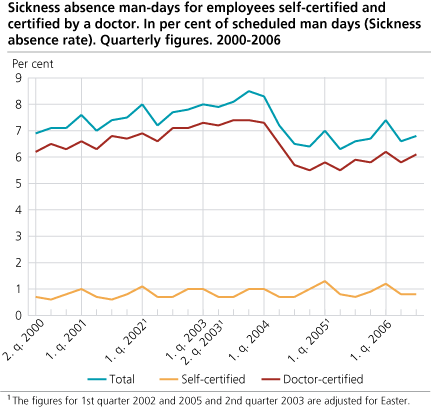Content
Published:
This is an archived release.
More sickness absence than in 2005
The sickness absence increased from 6.6 per cent to 6.8 per cent from the third quarter of 2005 to the third quarter of 2006. This corresponds to a rise of 3.3 percent, and gives about the same growth rates in the last 12 months as in the two previous quarters of 2006.
The sickness absence increased from 6.6 to 6.8 per cent from the third quarter of 2005 to the third quarter of 2006. Absence certified by a doctor increased from 5.9 to 6.1 per cent, and the self-certified absence increased from 0.7 to 0.8 per cent. For women, the sickness absence rose from 8.0 to 8.3 per cent and for men from 5.5 to 5.6 per cent.
The sickness absence was 8.3 1 per cent lower than in the third quarter of 2001, the year when the agreement on a more inclusive labour market was implemented.
Increase in most industries
Amongst the larger industries, the growth in sickness absence was largest in education and communication, with increases of 6.1 and 5.8 per cent respectively.
The lowest growth was in the health care and social work at 1.4 per cent, real estate and business activities at 1.9 per cent and construction at 2.0 per cent.
Decrease in Troms county
Troms was the only county with a decrease in the sickness absence. The decrease was 0.4 per cent from the third quarter 2005 to the third quarter 2006. The county with the lowest growth was Sør-Trøndelag by 0.2 per cent. The counties with the highest growths were Finnmark with 8.9 per cent, Østfold with 6.3 per cent and Oppland with 6.2 per cent.
Finnmark still had the highest level of sickness absence with 9.0 per cent while Rogaland had the lowest with 5.3 per cent.
Stable proportion of long-term absence
From the third quarter of 2005 to the third quarter of 2006 there were only small changes in the distribution between short and long-term absence. The proportion of doctor certified sickness absence lasting more then 31 days rose from 61.6 to 62.2 per cent. The proportion of self-certified sickness absence compared to the total sickness absence (self-certified and doctor-certified) dropped from 10.9 per cent to 10.8 per cent during the same period.
Strongest increase in central government
The sickness absence increased in all sectors. The strongest growth was in central government including state hospitals with 4.5 per cent. Within this sector, the sickness absence increased by 9.0 per cent in education (universities and colleges). Within health care (mainly state hospitals) the sickness absence increased by 4.3 per cent.
Local government had the lowest growth at 2.5 per cent. Within this sector, the sickness absence in education (primary and high schools) grew by 6.7 per cent.
Within the private sector and public enterprises the sickness absence increased by 3.4 per cent. Amongst the larger industries within this sector, transport and communication had the largest growth by 5.9 per cent.
The following results are based on data on sickness absence certified by a doctor, as the survey on self-certified absence does not contain data on sickness absence by age.
Rise in all age groups
The sickness absence grew in all age groups between 20 and 66 years. The strongest increase was found in the age group 20-24 years, which had an increase of 5.2 per cent. The weakest growth was in the group 60-64 years with an increase of 2.4 per cent.
The sickness absence rate measures the proportion of scheduled man-days lost due to own sickness. The statistics do not cover self-employed persons.
| 1 | Corrected 21 December 2006 at 13:10 p.m. |
Tables:
- Table 1 Sickness absence man-days for employees self-certified and certified by a doctor. In per cent of scheduled man-days (Sickness absence rate). Quarterly figures. 2000-2006
- Table 2 Sickness absence man-days for employees self-certified and certified by a doctor, by sex. In per cent of scheduled man-days (Sickness absence rate). Quarterly figures. 2000-2006
- Table 3 Sickness absence man-days for employees self-certified and certified by a doctor, by industry and type of sickness absence. In per cent of scheduled man days (Sickness absence rate). Quarterly figures. 2000-2006
- Table 33 Change in per cent of the sickness absence rate from the same quarter last year, by industry and type of sickness absence. Quarterly changes. 2000-2006
Contact
-
Arbeidsmarked og lønn
E-mail: arbeidsmarked@ssb.no
-
Unn H. Høydahl
E-mail: unnh.hoydahl@ssb.no
tel.: (+47) 40 90 23 77

